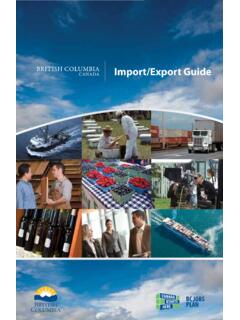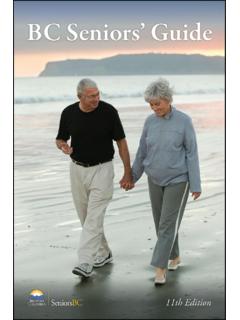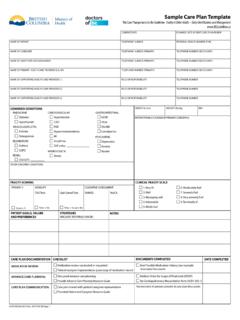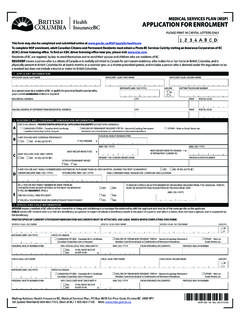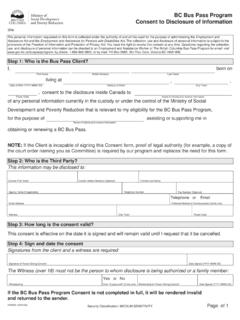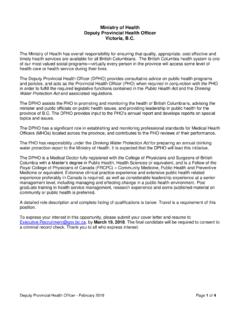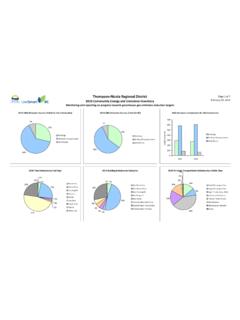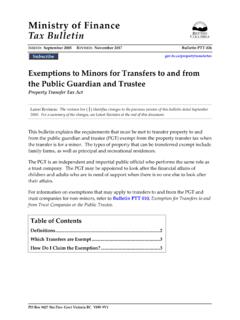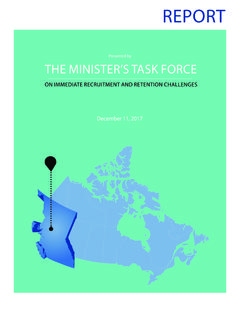Transcription of B.C. Graduation Program Implementation Guide - gov.bc.ca
1 Graduation Program Implementation Guide 1. AT A GLANCE. What Has Changed 1. Curriculum more learner-focused and flexible, with a focus on Big Ideas, core Competencies, and Learning Standards; Indigenous knowledges and perspectives thrive in the curriculum. 2. New course structures (see summary in following pages): i. 8 credits of Career Education with flexible delivery options and a Capstone. ii. Courses designed to easily allow different teaching methods and be accessible to all students. iii. Health Education combined with Physical Education. 3. Three new Provincial Graduation Assessments two Literacy Assessments and one Numeracy Assessment aligned with the curriculum. 4. Board/Authority Authorized (BAA) Guidelines updated to align with the curriculum. What Is Staying the Same 1. High curricular standards focused on foundational skills (reading, writing, math).
2 2. 80 credits required to graduate (52 required credits and 28 elective credits) representing a breadth of subject areas. 3. Letter grades and percentages appear on formal reports and transcripts for all courses taken. 4. No changes to independent directed studies, external credentials, course challenges, dual credit courses, equivalency credits or scholarships. Graduation Program Implementation Guide 2. Curriculum Structure Focus on learner-centred and flexible learning. Personalized options enable students to participate in choosing course content. An inquiry-based, hands-on approach encourages students to take more personal responsibility for learning. Teachers have greater flexibility in creating learning environments that are relevant, engaging, and novel, promoting local contexts and place-based learning. Curriculum structure has common components, regardless of subject.
3 These components work together to support deep learning. core Competencies (what students will be able to demonstrate) intellectual, personal, and social proficiencies demonstrated across curricular areas. Big Ideas (what students will understand) generalizations, principles, key concepts. Learning Standards Curricular Competencies (what students will be able to demonstrate) skills, strategies, processes demonstrated within a curricular area. Learning Standards Content (what students will know) essential topics and knowledge. Provide learners with a strong foundation of core Competencies, competencies that are driven by global and technological changes. These competencies encompass the intellectual, personal and social skills students need to develop for success in life beyond school and to become educated citizens. core Competencies are embedded within the learning standards of the curriculum.
4 They come into play when students are engaged in doing in any area of learning. Together, the literacy and numeracy foundations and core competencies contribute to the development of educated citizens. The core Competencies are: Communication the set of abilities that students use to impart and exchange information, experiences, and ideas to explore the world around them, and to understand and effectively engage in the use of digital media. Thinking (Critical and Creative) the abilities that students use to generate new ideas and concepts and to examine their own thinking and that of others. Personal and Social the set of abilities that relate to students' health, identity, and responsibility in the world, both as individuals and as members of their community and society. Courses are not designed to stream students into easier or difficult pathways.
5 All courses allow for different teaching methods and all students are able to access any course. Indigenous worldviews, perspectives, and content thrive in all curriculum (K-12). For example, place-based learning and emphasis on Indigenous ways of knowing reflect the First Peoples Principles of Learning in the curriculum. Graduation Program Implementation Guide 3. Literacy and numeracy skills are developed through applications in all curricular areas. A sustained focus is on reading, writing, and math as the core skills necessary for all students, including applications in the Graduation years. Course Structures Expanded course options in each subject area. The course options reflect a broad diversity and respond to emerging trends and student preference. a) English Language Arts and English First Peoples: Require 12 credits (4 credits in each grade) for Graduation .
6 Choices available for students: 9 courses for Grade 10;. 8 courses for Grade 11; 7 courses for Grade 12, including choice of the required course (either English Studies 12 or English First Peoples 12) and 5 optional courses. More flexibility and choice options are available for students in English Language Arts 10, which can be taken as two 2-credit courses. b) Fran ais langue premi re: Require 12 credits of Fran ais langue premi re for Graduation . Choices available for students: 3 courses for Grade 10; 3 courses for Grade 11; 1 course for Grade 12. More flexibility and choice options are available for students in Fran ais langue premi re 10 and 11 courses. Fran ais langue seconde-immersion: Require 12 credits of Fran ais langue seconde-immersion. Choices available for students: 1 course for Grade 10; 4 courses for Grade 11; 5 courses for Grade 12, including 1 required course and 4 optional courses taken as 4-credit courses.
7 C) Indigenous Languages: 17 Indigenous languages with provincial curriculum: Gitxsenimx ~Gitxsanimax, Halq'em ylem, Heiltsuk, Hul'q'umi'num', Kwak'wala, Liqwala/Kwakwala, ns ylxc n, Tsek'ene, Upper St'at'imcets, Xaayda Kil / Xaad Kil, Nte?kepmxcin, Nuu aan u , Secwepemctsin, SEN O EN, Shashishalem, Sim'algaxhl Nisga'a, and Sm'algyax. The current languages template for developing new languages courses can be found on the ministry website. An updated curriculum template is being developed for Indigenous languages. d) Mathematics: Require 8 credits for Graduation during Grades 10-12 (4 credits in Grade 10 and 4 credits in either Grade 11 or 12). Additional choice options are available for students in Grades 10-12 such as Geometry 12, History of Math 11, and Computer Science 12. e) Science: Require 8 credits for Graduation during Grades 10-12 (4 credits in Grade 10.
8 And 4 credits in either Grade 11 or 12). Additional choice options are available for students in Grades 11 and 12, such as Specialized Science 12, Science for Citizens 11, and Environmental Science 11 and 12. f) Social Studies: Require 8 credits for Graduation between Grades 10-12 (4 credits in Grade 10 and 4 credits in either Grade 11 or 12). Additional choice options are available for students in Grades 11 and 12, such as Explorations in Social Studies 11, Genocide Studies 12, Asian Studies 12, and Contemporary Indigenous Studies 12. The additional choice options provide greater flexibility when selecting social studies courses for credit toward Graduation . Graduation Program Implementation Guide 4. g) Second Languages: 9 second languages aligned with curriculum model: American Sign Language, core French, German, Italian, Japanese, Korean, Mandarin, Punjabi, and Spanish.
9 An updated template is being developed for additional locally developed second languages curriculum. h) Arts Education: Require 4 credits for Graduation in either Arts Education or Applied Design, Skills, and Technologies, or a combination of both; available as 2- or 4-credit courses in Grade 10, and as 4-credit courses in Grades 11 and 12, depending on school. Additional choice options are available for students in Dance, Drama, Music and Visual Arts in Grades 10-12. i) Applied Design, Skills, and Technologies: Require 4 credits for Graduation in either Applied Design, Skills, and Technologies or Arts Education, or a combination of both;. available as 2- or 4-credit courses in Grade 10, and as 4-credit courses in Grades 11. and 12, depending on school. Additional choice options are available for students in Media Design, Business Education, Home Economics, Culinary Arts, Technology Education, and Information and Communications Technology in Grades 10-12.
10 J) Career-Life Education: 8 credits of Career Education required for Graduation as two courses Career-Life Education (CLE) and Career-Life Connections (CLC): CLE and CLC do not have a designated grade level, allowing flexible delivery. Courses can be taken as a single 4-credit course, or as two 2-credit courses. A final grade will be provided for CLC (compared to Requirements Met used in Graduation Transitions). A minimum of 30 hours of work experience or career-life explorations is included as a component of CLC. A Capstone is included as a component of CLC. k) Work Experience and Apprenticeship Training: Students are able to earn credits toward Graduation for work-based hours in a real-world setting, including where students' paid and unpaid work aligns with their career/educational path. Program guides are being updated to align with curriculum.
